Breathing Mismanagement of Newborns
During birth, babies are in a state of transition and adaptation. While developing in the womb, the baby's mother ensures their growth and development by providing essential nutrients and oxygen through the placenta and umbilical cord. As soon as they're born, the baby transitions from relying on their mother’s umbilical cord for essential life support to taking their first breath and using their lungs for breathing. Most babies come out of the womb and can breathe on their own. However, about 10% of babies struggle with the ability to breathe outside the womb without assistance, and 1% will require extensive resuscitative measures.

When babies are not able to get adequate oxygen, medical professionals who assist in the delivery of babies, like pediatricians, neonatologists, nurses, and other hospital staff, have a duty to provide immediate breathing intervention methods to prevent serious complications. Without prompt attention and the correct level of care, newborns requiring resuscitation can suffer irreparable harm and severe birth injuries like cerebral palsy (CP), hypoxic-ischemic encephalopathy (HIE), and other brain injuries.
Birth Injury Lawyers
1-888-987-0005The birth injury attorneys at Miller Weisbrod Olesky are dedicated to providing compassionate legal support to families and their children living with a birth injury, such as cerebral palsy.
Parents of children who have been harmed by neonatal resuscitation errors often want answers. Our dedicated birth injury lawyers want to help you find those answers by listening to your story, explaining your rights and options, and discussing the possible next steps if you would like to file a medical malpractice claim. With the help of our team of registered nurses and nurse-attorneys, we will gather and analyze medical records, consult with expert witnesses, and review the details of your case to determine the strength of your claim.
We have an extensive history of successful verdits and settlements pertaining to birth injury lawsuits. Let us help you and your child obtain the justice they deserve.
What is Neonatal Respiration?
A baby who cannot breathe or struggles to breathe at birth may need to be resuscitated. Neonatal resuscitation refers to a series of emergency procedures performed by a doctor to stimulate and assist newborn infants in breathing after delivery if they are not breathing on their own. Usually, routine afterbirth care (drying, clearing airways, warming) is all that is required if the baby is born at or near term, has a healthy color or skin tone, and is breathing normally or crying normally.

If the baby's heart rate is less than 100 beats per minute (bpm), they are blue, not crying or one of many other conditions known to be a sign or symptom of inadequate oxygen (breathing), some level of resuscitation effort is required. After delivery, there are many different ways of getting oxygen to the baby's brain. Whether it's providing Positive Pressure Ventilation (PPV) with a bag-mask device, administering chest compressions, or using specialized equipment such as Endotracheal Tubes for intubation, the chosen method will usually depend on the infant's specific situation.
Common Signs That Respiratory Support Might Be Necessary
Throughout an expectant mother's pregnancy, doctors have a responsibility to monitor the health and development of the fetus, ensuring that both the mother and the baby are safe. To determine if neonatal resuscitation might be necessary, healthcare providers should notice any signs that the baby is not growing as expected, as well as other concerning symptoms. Additionally, they should pay attention to any medical conditions the mother may have that could increase the risk of labor complications.
Resuscitation may be necessary immediately if:
- The baby is not breathing
- There is no pulse
- They are unconscious
- They are blue or pale in color rather than pink
Aside from an absent cry at birth, Apgar score measurements may reveal a newborn's need for breathing assistance within the first few minutes of their life. These scores are used to assess a newborn's overall health and diagnose any potential respiratory issues.

What Is APGAR?
- Appearance: The newborn's skin color. Ideally, the baby's skin color should be pink. A blue or pale skin color may indicate poor oxygenation and circulation
- Pulse: The baby's heart rate and strength. An abnormal or weak pulse may indicate the need for immediate neonatal resuscitation
- Grimace: The newborn's response to stimulation, such as gently squeezing their nose. A weak or absent response may indicate potential respiratory issues
- Activity: The baby's muscle tone and movement. If the baby’s muscle tone is floppy or weak, it may indicate the need for resuscitation
- Respiration: The newborn's breathing pattern and effort. Neonatal resuscitation may be necessary if the baby is not breathing or struggling to breathe

Each category is given 0-2 points based on specific observations made shortly after birth. An Apgar score of 7 or higher indicates that the baby is in good overall health. However, a lower score could indicate the need for immediate intervention.
As well as the presence of complications that occur during labor and delivery, there are certain risk factors that are evident during pregnancy and can help medical professionals determine that a baby may need to be resuscitated when they're born.
Some common risk factors include:
Maternal Medical Conditions
- Advanced or very young maternal age (women who are under the age of 16 or over 40 are more prone to labor complications)
- Gestational diabetes
- Maternal hypertension (preeclampsia)
- Prior stillbirth or miscarriage
- Maternal Infections or other serious conditions (group B strep, cardiovascular disease, obesity)
- Previous high-risk pregnancy
Labor and Delivery Events
- Multiple gestations (two or more babies)
- Fetal distress or an abnormal electronic fetal monitor strip
- Prolonged Labor
- Preeclampsia
- Fetal macrosomia (a larger-than-normal infant)
- Intrauterine growth restriction (IUGR)
- Placenta previa
- Irregular fetal heartbeat
- Pre-term or post-term birth
- Placental abruption
- Birth asphyxia
- Shoulder dystocia
- Assisted delivery (forceps or vacuum extractors)
- Emergency C-section
- Premature rupture of the membrane (PROM)
- Prolapsed umbilical cord
- Meconium aspiration syndrome (MAS)
- Breech birth
Surfactant is a substance produced by the lungs that reduces surface tension in the Alveoli, allowing them to expand and fill with air during breathing. Because premature babies are more likely to have underdeveloped lungs that are unable to expand after the liquid squeezes out of them during birth, they are more likely to need resuscitation.
The Neonatal Resuscitation Program (NPR) is an American Academy of Pediatrics (AAP) and American Heart Association certification program that provides guidelines and protocols for neonatal specialists and all delivery room personnel to effectively resuscitate newborns suffering respiratory distress.
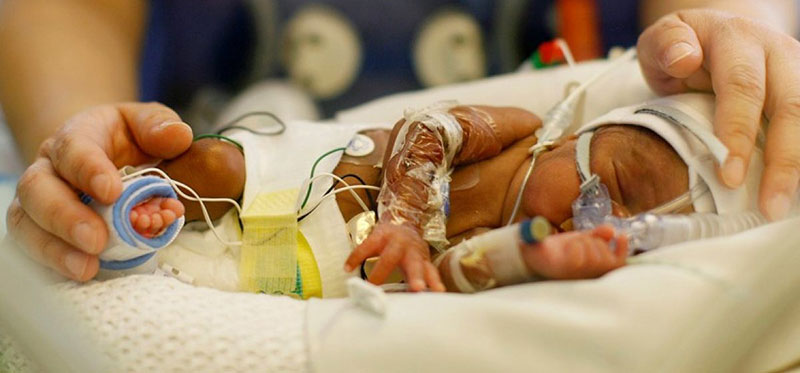
The NPR recommends that premature babies receive surfactant right after birth or in utero after 30 weeks. If meconium is detected, the nose and mouth should be suctioned. Therefore, it is imperative that medical staff ensure a ventilator is readily available and that there is warm clothing, a wrap, and a mattress for a newborn preterm baby whose immature lungs may require resuscitation.
If a doctor fails to consider these factors and neglects to have the tools in place to help the child breathe, it can result in the baby being deprived of oxygen and diminished blood flow, which can lead to brain injuries and damage to the heart.
Interventions, Treatments, and Equipment for Newborn Respiration Support
Preparing for potential resuscitative efforts involves identifying any risk factors that may increase the likelihood of reduced oxygen during childbirth and ensuring that a team of well-equipped and trained healthcare professionals is readily available. As soon as a woman in labor arrives at the hospital, nurses should begin taking her vital signs and attaching two electronic monitors to the mother's abdomen. One to monitor the mother's contractions , and another device that monitors the fetal heart rate in response to contractions (electronic fetal monitor).

The key to successful neonatal resuscitation is preparation. The following equipment used for neonatal resuscitation should be available in the delivery room before the baby is born.
- Suction bulbs and mechanical suction devices
- Endotracheal tubes
- Laryngeal mask airways
- Positive-Pressure Ventilation (PPV) face masks
- Laryngoscopes
- Pulse oximeter
- Medication for volume expansion
- Supplemental oxygen
- Epinephrine
- Radiant warming units
- Pressure transducer and monitor
- Cardiotachometer with electrocardiogram oscilloscope
In the seconds following a newborn's birth, assessments to determine whether neonatal resuscitation is needed should be conducted. If a term newborn has good muscle tone and is breathing and crying, it is likely that they will not need resuscitative assistance. However, upon determining the need for neonatal resuscitation, medical professionals should proceed with the following interventions.

It is critical that the labor and delivery team reach out to qualified specialists like neonatologists, neonatal nurses and even anesthesiologists to assist them in providing appropriate neonatal resuscitation since these specialized practitioners have unique training and experience in this field. Failure to alert the appropriate team members to attend the birth is a violation of the standard of care.
Stabilization
When a baby needs respiratory support (not breathing and slow heart rate), medical professionals should begin by warming, drying, properly positioning the baby, providing tactile stimulation, and clearing the baby's airway if necessary. The first important step is getting the baby warm and dry. Next, a doctor or nurse should stimulate the infant by rubbing their back and squeezing their feet. If mucus or secretions are blocking the newborn's airway, a medical professional should attempt to clear the baby's airway by suctioning out any fluid.
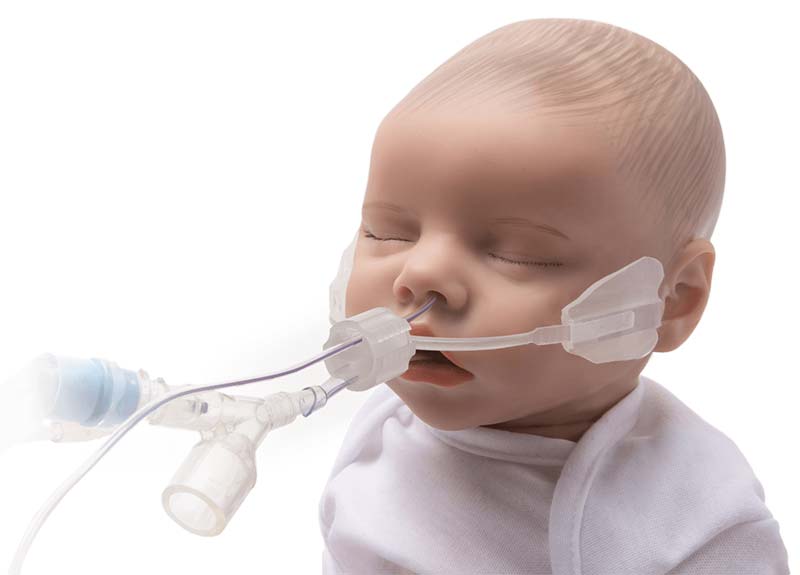
In these circumstances, a special Endotracheal suctioning tube (ET) is carefully inserted into the newborn's airway to draw out or aspirate the blockage. Suctioning the airways should only occur when there is reason for it. The risks involved with airway suctioning include reduced oxygen availability, slowing the baby's heart rate, hypotension, and pneumothorax. This may be the only intervention required if the baby responds positively and begins spontaneously breathing.
Supplemental Oxygen Administration
When a baby is breathing on its own but not getting enough oxygen, then a doctor may administer supplemental oxygen. This form of infant resuscitation is a less invasive, life-saving measure for newborns in need of breathing assistance. To determine when the administration of oxygen is appropriate, medical professionals use a pulse oximeter to measure the oxygen saturation levels in the baby's blood.
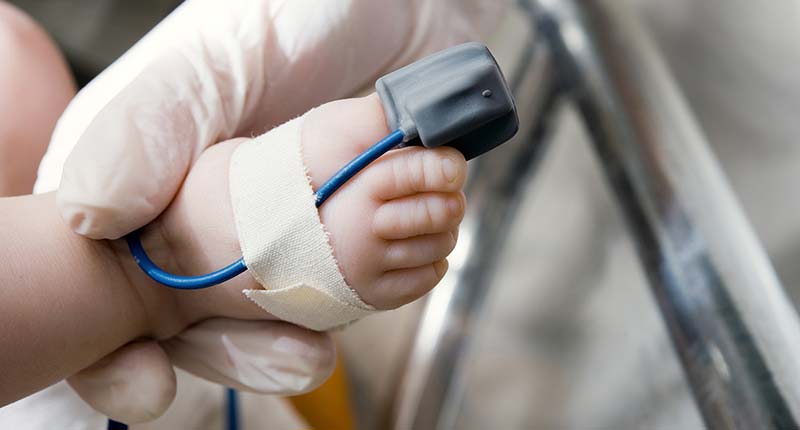
Supplemental oxygen administration involves providing the baby with additional oxygen through a device such as a nasal cannula, oxygen mask, or oxygen hood. The method of supplemental oxygen administration is determined by the severity of the baby's condition and an assessment of the baby's respiratory needs. There are serious risks associated with the administration of supplemental oxygen.
For example, the use of too much oxygen can cause complications such as collapsed or damaged lungs, Retinopathy of Prematurity (ROP), and Bronchopulmonary Dysplasia (BPD). It is imperative that the medical team follow guidelines and target ranges for oxygen levels when performing resuscitation procedures to ensure that the baby receives enough oxygen.
What is Retinopathy of Prematurity (ROP)?
Retinopathy of prematurity (ROP) is when abnormal blood vessels form in a baby’s retina. Babies born before 31 weeks or who weigh less than 3.3 pounds are most at risk. Screenings detect ROP soon after birth. Most cases of ROP go away on their own without treatment. But some babies need a laser procedure or other treatments to prevent vision loss.
What is Bronchopulmonary Dysplasia (BPD)?
BPD is a serious lung condition that affects newborns. Most newborns who develop BPD are born more than 10 weeks before their due dates, weigh less than 2 pounds at birth, and have breathing problems. Babies are not born with BPD. Instead, they develop it as a complication of another breathing condition. For example, most babies who develop BPD are born with Respiratory Distress Syndrome (RDS).
Surfactant Therapy
Surfactant is a substance produced by the lungs that provides protection against injury, infection, and helps with breathing. A baby who has respiratory distress syndrome (RDS) does not produce enough surfactant, which prevents the lungs from expanding fully enough to take in a sufficient amount of oxygen.
In cases of RDS, surfactant therapy can help the baby's lungs expand and improve their ability to absorb oxygen. If an infant still suffers from severe respiratory distress after CPAP therapy, surfactant therapy may be recommended. However, surfactant therapy does come with some risks. Some of the risks associated with surfactant therapy include pulmonary hemorrhage, hypoxemia, bradycardia, and hyperventilation.
Continuous Positive Airway Pressure (CPAP)
The use of Continuous Positive Airway Pressure (CPAP) and supplemental oxygen should be considered for newborns with a heart rate > 100 beats per minute and labored breathing or cyanosis. CPAP is a non-invasive method that physicians try before they move on to invasive methods such as ventilatory support and endotracheal intubation.
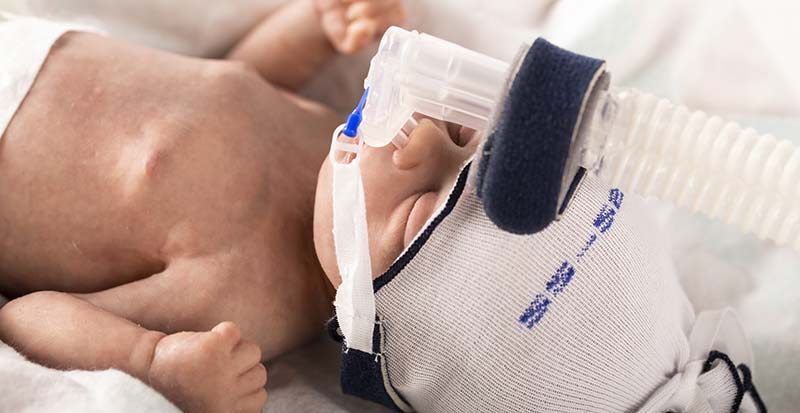
During CPAP administration, the baby wears a mask or nasal prongs and a machine delivers continuous pressure to keep the baby’s lungs open. Non-invasive positive pressure ventilation (NPPV) is a form of CPAP that gives the baby additional breathing assistance by delivering a set amount of full breaths that the baby does not have to initiate. CPAP is indicated for newborns with respiratory acidosis, respiratory distress syndrome (RDS), atelectasis, and apnea of prematurity.
What is Atelectasis?
Atelectasis, the collapse of part or all of a lung, is caused by a blockage of the air passages (bronchus or bronchioles) or by pressure on the lung.
What is Apnea of Prematurity?
Apnea of prematurity occurs when newborns, especially those born prematurely, stop breathing for short periods of time. Apnea can be caused by immaturity of the brain and weakness of the muscles that keep the airway open.
Positive Pressure Ventilation (PPV)
Whenever the baby's heart rate is less than 100 bpm, is gasping, or apneic, positive pressure is recommended. It is designed to improve the exchange of air between the lungs and the outside world via a mask, inflating bag, or T-piece Resuscitator. Ventilation consists of delivering a controlled amount of air or oxygen into the baby's lungs. This helps to provide adequate oxygenation and support the baby's respiratory function.
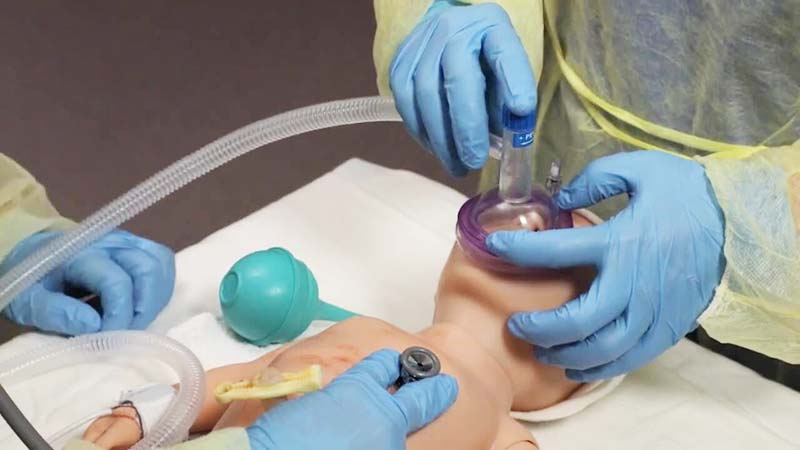
Some of the risks associated with PPV include Barotrauma, which is the potential for lung damage caused by excessive pressure during ventilation. Other risks of PPV include pneumothorax, a condition where air or gas accumulates in the space between the lungs and the chest wall.
Endotracheal Intubation
Endotracheal intubation may be necessary for babies with heart rates below 60 bpm or if PPV is not successful. Endotracheal intubation is the process of inserting a tube through the nose or through the mouth into the trachea. A Nasogastric tube may be required for premature infants. This provides a secure airway for ventilation and allows for the delivery of oxygen and other respiratory support directly into the lungs.
Airway obstructions and secretions can be relieved with intubation. There are risks and complications associated with intubation, such as hypoxia (if the process takes too long), placement injuries, contamination risks, and the possibility of inhaling vomit. While ventilating the lungs, a resuscitation specialist will monitor the infant’s heart rate, C02 output, and oxygen levels to protect their delicate lung tissue and assess breathing.
Chest Compressions
When previous efforts have not worked, it may be necessary to move on to chest compressions. A specialist will gently press down on the center of the baby's chest with two or three fingers to help push blood through the heart and surrounding vessels when performing chest compressions.
It is recommended that neonatal chest compressions be performed if a baby's heart rate remains below 60 bpm despite receiving sufficient oxygenation (via PPV or intubation) for 30 seconds. If chest compressions are not done with skill, the baby could suffer broken ribs, a collapsed lung, or damage to the chest and liver.
Medications
It may be necessary to prescribe certain medications if a newborn's heart rate remains less than 60 bpm despite sufficient ventilation, oxygen administration, and chest compressions. Medications such as Epinephrine or adrenaline can be administered intravenously to stimulate the infant's heart rate.
Epinephrine, a hormone and intervention for resuscitation, works by stimulating the beta-adrenergic receptors in the heart. This increases the strength and frequency of the heart's contractions, ultimately raising the heart rate to a more normal range. Its administration helps to improve blood flow to vital organs and increases the chances of successful resuscitation in newborns with persistently low heart rates.
Volume Expander
The use of a volume expander, which coats the lungs with a saline solution, may help an infant's oxygen levels rise, and heart rate stabilize to 60 bpm if chest compressions and medication have failed. A newborn may also require an expander if they have low blood pressure or have lost too much blood during birth. A volume expander increases the volume of blood in the circulatory system, which helps improve tissue perfusion and oxygen delivery to vital organs.
Any infant who has received preliminary or advanced resuscitation requires round-the-clock monitoring to ensure their stability and detect any potential complications or adverse reactions that may arise. The medical team may face the difficult decision of whether to continue resuscitation after 20 minutes if the baby does not respond to chest compressions, medication, and volume expansion. According to the NPR, ceasing resuscitation efforts is a challenging decision that requires parental consent.

Once the baby's condition improves, resuscitation will cease, and the newborn will be handed over to its mother. Medical professionals should continue to the next step if a baby is still gasping, has apnea, labored breathing, cyanosis, or a heart rate less than 100 bpm. A doctor or other healthcare provider's failure to provide the necessary equipment, perform the appropriate assessments, and initiate neonatal resuscitation in a timely manner can cause the baby to sustain devastating birth injuries and may constitute medical negligence. The risk of severe brain injuries, cerebral palsy, cognitive disabilities, seizure disorders, and death increases with any delay in initiating resuscitation.
Conditions That Result from Neonatal Resuscitation Errors
All observations and efforts to resuscitate a newborn must come quickly, any time there is a lack of oxygen to the brain, there is a risk for severe brain injuries. Among the many complications from delayed resuscitation errors are cognitive impairments, developmental delays, physical disabilities, and other long-term health problems.

The following are some of the consequences of neonatal resuscitation errors:
- Cerebral Palsy (CP)
- Seizure disorders
- Pneumonia
- Hypoxic-ischemic encephalopathy (HIE)
- Cognitive disabilities
- Respiratory distress syndrome (RDS)
- Vision and hearing impairments
- Increased risk of neonatal mortality
- Periventricular leukomalacia (PVL)
Family members raising a child with a long-term disability may experience depression and anxiety. It can also cause significant financial strain on the family, as they may need to cover the costs of ongoing medical treatments, therapies, and specialized equipment.
Compensation recovered through a successful birth injury claim can help to alleviate the financial burden on families, allowing them to focus on the well-being and care of their child without the added stress of financial obligations. Our birth injury attorneys understand the emotional and financial toll these conditions can have on families, and we are dedicated to fighting for your child's rights and ensuring they receive the support they need.
Common Resuscitation Errors Made by Medical Professionals
In infant resuscitation, nurses, doctors, and other healthcare staff must recognize when a baby is struggling to breathe and requires immediate resuscitation efforts. If a baby isn’t breathing enough to keep oxygen circulating to the brain and heart, the goal is to swiftly and effectively provide the baby with oxygenation and monitor the baby’s condition regularly. Neonatal resuscitation errors can occur in a number of ways.

The most common ways include the following:
- Delays in performing resuscitation
- Failure to clear the airways
- Improper placement of intubation tubes
- Failure to initiate intubation
- Improper resuscitation technique
- Failure to alert and assemble the appropriate team at birth
- Miscommunication between doctors and other hospital staff
- Failure to monitor the baby’s breathing or oxygen saturation level
- Delays in administering surfactant therapy
- Performing overly aggressive chest compressions
- Failure to give bag and mask oxygen
- Failure to recognize fetal distress, a hypoxic or anoxic condition
- Failure to use surfactant therapy
- Failure to perform o delaying a necessary C-section
- Failing to stabilize the baby in a timely manner
- Failure to monitor a high-risk baby
- Negligent hiring or untrained staff
The delicate balance between machinery and monitoring, as well as reviving heartbeats, requires the expertise of medical professionals familiar with the unique dangers each newborn faces during pregnancy and after birth. Doctors, nurses, and other hospital staff have a duty of care to mothers and newborns at every stage of labor and delivery. When these procedures are not performed properly or at the appropriate time, critical deprivation of adequate oxygen and blood flow to the baby can lead to disability and permanent brain injuries.
Medical Malpractice in Birth Injury Cases
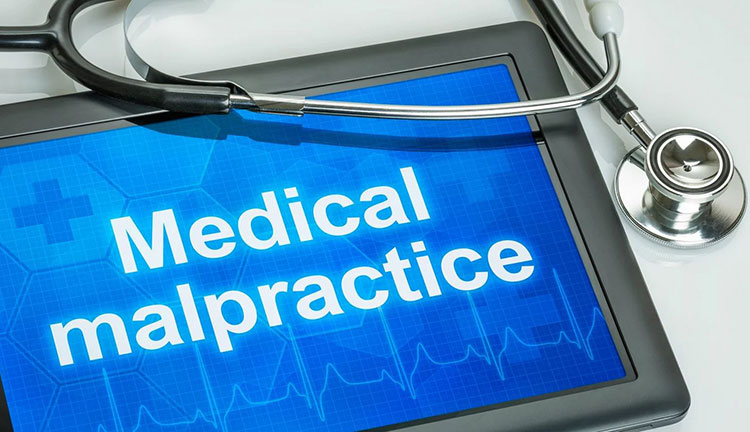
When doctors, nurses, or other healthcare professionals commit medical negligence before, during, or after delivery, it can result in injuries to a mother, her child, or both. Even though not every birth injury is caused by medical malpractice, an experienced birth injury attorney can help make sure your child is compensated fairly if their provider was negligent in their care.
There are several examples of acts of medical negligence that can cause birth injuries during childbirth:
- Failure to recognize and treat signs of maternal or fetal distress, such as lack of oxygen
- Improper use of forceps or a vacuum extractor
- Using too much force during delivery
- Failure to schedule an emergency cesarean section (C-section)
- Delaying in performing an emergency C-section
- Failure to properly monitor the mother during her pregnancy
- Failure to administer the proper antibiotics or administering the wrong antibiotics to a mother with an STD or other maternal infections before delivery
- Ignoring or misreading a fetal monitoring strip
- Failure to detect and treat an umbilical cord complication
- Failure to diagnose and treat preterm labor in a timely manner
- Failure to treat maternal elevated blood pressure (preeclampsia)
- Failure to properly resuscitate a newborn after delivery
- Failure to treat jaundice and kernicterus
- Failure to respond to signs of a placental abruption
- Failure to detect a severe birth defect on a prenatal ultrasound
- Failure to carefully manage an abnormal fetal position
- Administering too high a dose of labor-inducing medications like Pitocin
Failing to address complications such as a preterm delivery or umbilical cord issues can result in a serious birth injury. As leaders in our communities, we rely on medical professionals to provide high-quality health care. Generally, when people think of medical malpractice liability, they picture doctors and nurses. However, other parties involved in the care of a pregnant woman and her baby may also be held responsible in a birth injury lawsuit.

Medical negligence may be committed by one or more of the following types of medical providers or facilities:
- Obstetricians (OB-GYN)
- Other obstetric professionals
- Pediatricians, including pediatric neurologists
- Anesthesiologists
- Labor and delivery nurses
- Midwives
- Nurses
- Hospitals and medical facilities
- Hospital administrators
- Other hospital staff
- Neonatal nurses and aids
- Neonatologists or pediatricians providing neonatal care
- Respiratory therapists
- Maternal-fetal medicine physicians and specialists (MFM)
- Laboratory staff
Although medical malpractice suits are often filed against healthcare providers like doctors and nurses, hospitals can also be held liable in certain circumstances. A hospital can be vicariously liable for an employee's negligent actions that caused harm during work hours or while the employee was performing a job-related task. For example, if an OBGYN makes a negligent mistake during pregnancy or delivery, the hospital can be held vicariously liable.
A hospital may also be held directly liable for its own actions. For instance, a hospital failing to adhere to medical protocols and standards may be directly liable for a patient's injuries. We can help you determine whether your child's birth injury was caused by a doctor, the hospital itself, or another medical professional.
When you file a birth injury claim, your lawyer must be prepared to present evidence that proves that a doctor's or hospital's negligence caused your child's birth injury. An injured plaintiff must be able to prove each of the following four legal elements in their birth injury lawsuit.
- Duty of care: Before the provider will have a duty of care, the plaintiff must be able to establish a provider-patient relationship. Upon establishing this relationship, the medical provider is expected to meet a relevant standard of care that a medical professional with the same specialization would have exercised under the same conditions.
- Breach: The next element the plaintiff must prove is that the healthcare provider or facility breached that duty by failing to meet the applicable standard of care.
- Causation: The plaintiff must then demonstrate that the healthcare provider's negligent care directly caused their or their child's injuries.
- Damages: Finally, the plaintiff must show that the harm they or their child suffered resulted in specific expenses and other losses. These losses may include anything from the cost of lifelong medical care to emotional suffering.
The plaintiff's attorney must present compelling evidence to establish liability and recover damages in birth injury cases. At Miller Weisbrod Olesky, our experienced birth injury lawyers can collect evidence on your behalf, consult with medical experts to determine the cause of the injury, and identify all medical professionals who contributed to you or your child's birth injury.
Filing a Birth Injury Malpractice Lawsuit
Parents may file a birth injury lawsuit on behalf of their child against negligent medical professionals responsible for causing their child to sustain a preventable birth injury. Families may seek compensation to cover their child's medical and treatment costs through a Birth Injury lawsuit.
It is important to note that while every case is different, most lawsuits typically follow a similar process. If your child was injured by a doctor, nurse, or other healthcare provider, a dedicated birth injury lawyer can file your case, gather evidence, and pursue full and fair compensation on your behalf.

Free Case Review
Our birth injury lawyers will determine if you are eligible to file a birth injury lawsuit during your complimentary case review, which you can schedule by contacting us via our toll-free line at 888-987-0005 or by filling out our convenient online form. If we can determine that medical malpractice may have played a role in your child's birth injury, your case will likely be accepted by our team.
Gather Evidence
A birth injury malpractice attorney will gather information and evidence related to your case as soon as they determine you qualify to pursue a lawsuit. Evidence like medical records, witness statements, and the employment history of the medical professional in your case are crucial to proving that your child's birth injury was caused by medical negligence.
File the Lawsuit
After gathering the necessary information, your attorney will file your lawsuit in the appropriate court. As soon as the case is filed, you and your family will become the plaintiffs (the party taking legal action). The healthcare professionals who may be responsible for causing your child's injury will become the defendants (the party being sued). The statute of limitations in each state governs the deadline for filing a birth injury lawsuit.
Your lawyer will ensure your case is filed on time according to your state's statute of limitations. The lawsuit outlines the charges against the defendants and gives them around 30 days to respond. If the defendants fail to respond, judgment will automatically be entered in the plaintiff's favor. In the event the defendants respond but fail to assume responsibility, they will explain why they believe they are not to blame for your child's injury.
Discovery
Your attorney will gather more evidence, such as medical records, medical expense reports, and other documents related to your case, once the defendants file their response. During this time, you, your loved ones, and medical experts may be required to give statements under oath. The parties will also exchange information and evidence relevant to their respective cases to build strong arguments. To prove that medical professionals failed to uphold a high standard of care, an experienced attorney will collect all legally required evidence.
Settlement Negotiations
Settlement negotiations can begin once both parties have prepared their cases. During this phase, both parties will try to reach an agreement (settlement) that allows them to resolve their dispute without going through a full trial. Should a settlement be reached, the defendants will pay you a lump sum, and all legal action will stop. If the case cannot be resolved during this stage, our lawyers have the experience and knowledge to represent your best interests in court.
Go Through a Trial
Cases that do not settle through settlement negotiations will go to trial. A jury and judge will examine all the evidence presented by both legal teams during the trial. A verdict is reached after each party has presented their case and a judgment has been entered. The losing party may decide to appeal the decision in some cases.
The disadvantage of trials is that, while you might receive more compensation than you would receive from a settlement, you risk receiving no compensation at all if you lose. Our birth injury lawyers can help you obtain the compensation you need to cover the cost of your child's care and other injury-related expenses.
Statute of Limitations for Birth Injury Cases

A statute of limitations is a law that imposes a deadline for filing birth injury lawsuits. If you fail to file a claim before the statute of limitations "runs out," you may lose your right to pursue legal action and seek compensation. In some cases where an injury may not be immediately apparent, the statute of limitations may be extended.
The discovery rule prevents the statute of limitations from running until the injury is discovered or reasonably should have been discovered. It is also important to remember that the statute of limitations varies by state and the type of claim you're filing. A birth injury attorney can help you avoid missing all crucial deadlines related to your case.
Meet with an Experienced Birth Injury Lawyer Today!
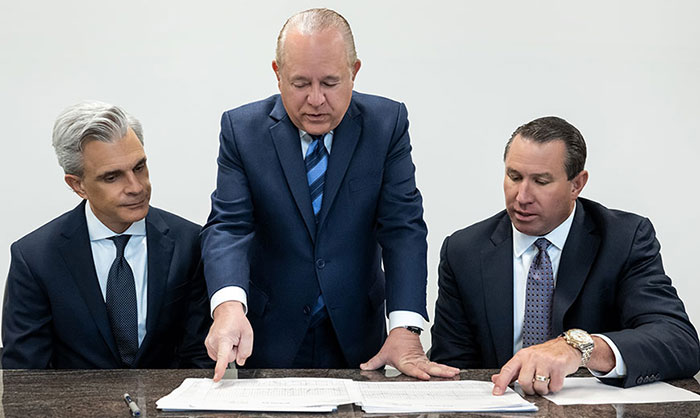
Resuscitation errors at birth can leave a lasting impact on the affected child and their family, leading to emotional trauma, developmental delays, and significant financial burdens. In most instances, these errors result from a medical professional failing to live up to the recommended standards of practice, delaying emergency resuscitation, or making errors in the process of infant resuscitation.
If your child suffered harm due to a healthcare provider's negligent or careless mistakes, you do not deserve to suffer the consequences of birth injuries without holding the responsible parties accountable.
Our birth injury attorneys at Miller Weisbrod Olesky believe your baby deserves the utmost care and concern at all times. We are prepared to work tirelessly to recover the compensation you need to support your child's recovery and long-term care. Our history of recovering successful verdicts and settlements for medical malpractice victims and their families speaks for itself.
We offer a free initial case evaluation and handle cases on a contingency fee, meaning you NEVER pay any up-front fees unless we win your case. Set up your complimentary consultation with one of our attorneys by calling our toll-free line at 888-987-0005 or by filling out our online contact form.
